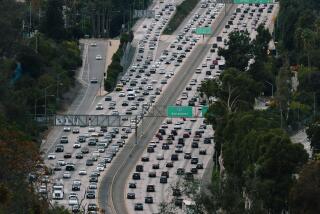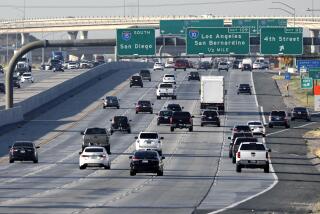Opening carpool lanes may be safer
- Share via
Allowing drivers to go in and out of freeway carpool lanes when they want to results in fewer and less severe accidents, a study by UC Berkeley transportation researchers has found.
The preliminary report, released Tuesday, found that Caltrans’ policy of using yellow lines to restrict access to carpool lanes offers no safety advantage. In addition, carpool lanes that limit access result in more collisions and injury accidents than those with flexible access, Berkeley’s Traffic Safety Center and Partners for Advanced Transit and Highways found.
The study adds ammunition to the Orange County Transportation Authority’s attempt to persuade Caltrans to increase carpool access on freeways in Orange County as a way to relieve congestion.
“We’re obviously very pleased with this study,” OCTA Chairwoman Carolyn Cavecche said. “This is going to give that last little push to give us continuous access for all our freeways in Orange County.”
Since December, the OCTA has eased access to carpool lanes on the Garden Grove Freeway as an experiment.
“The study confirms what many of us on the board have thought,” Cavecche said. “With limited access you can have people shooting across four lanes of traffic to get out of the carpool lane and exit the freeway.”
Orange County Supervisor Bill Campbell, also an OCTA board member, was disappointed that the study didn’t examine whether solo drivers could use carpool lanes during off-peak traffic hours, as is done in some parts of the Bay Area and Sacramento.
Researchers found that limited-access carpool lanes had 3.6 collisions per mile compared with 3.2 collisions per mile for continuous-access lanes. It also found that 19% of collisions on restricted carpool lanes involved injury compared with 8.9% on continuous-access lanes. The study analyzed statistics from freeways in Northern California and Texas.
UC Berkeley’s carpool study won’t be concluded until June. Despite the nature of its early findings, it may be premature to act on them, said James Pinheiro, Caltrans deputy director in Orange County.
“What we know now is the accident rates are marginally less on the continuous systems,” he said. “But we don’t know why yet, and they will continue the study and try to dig into the why.”
Transportation officials in neighboring counties worry that if Orange County has a different carpool policy, motorists could become confused.
On Tuesday, the OCTA sent a letter to transportation agencies in Los Angeles, Riverside, San Bernardino and Ventura counties advising them of the study, Leahy said.
More to Read
Sign up for Essential California
The most important California stories and recommendations in your inbox every morning.
You may occasionally receive promotional content from the Los Angeles Times.










